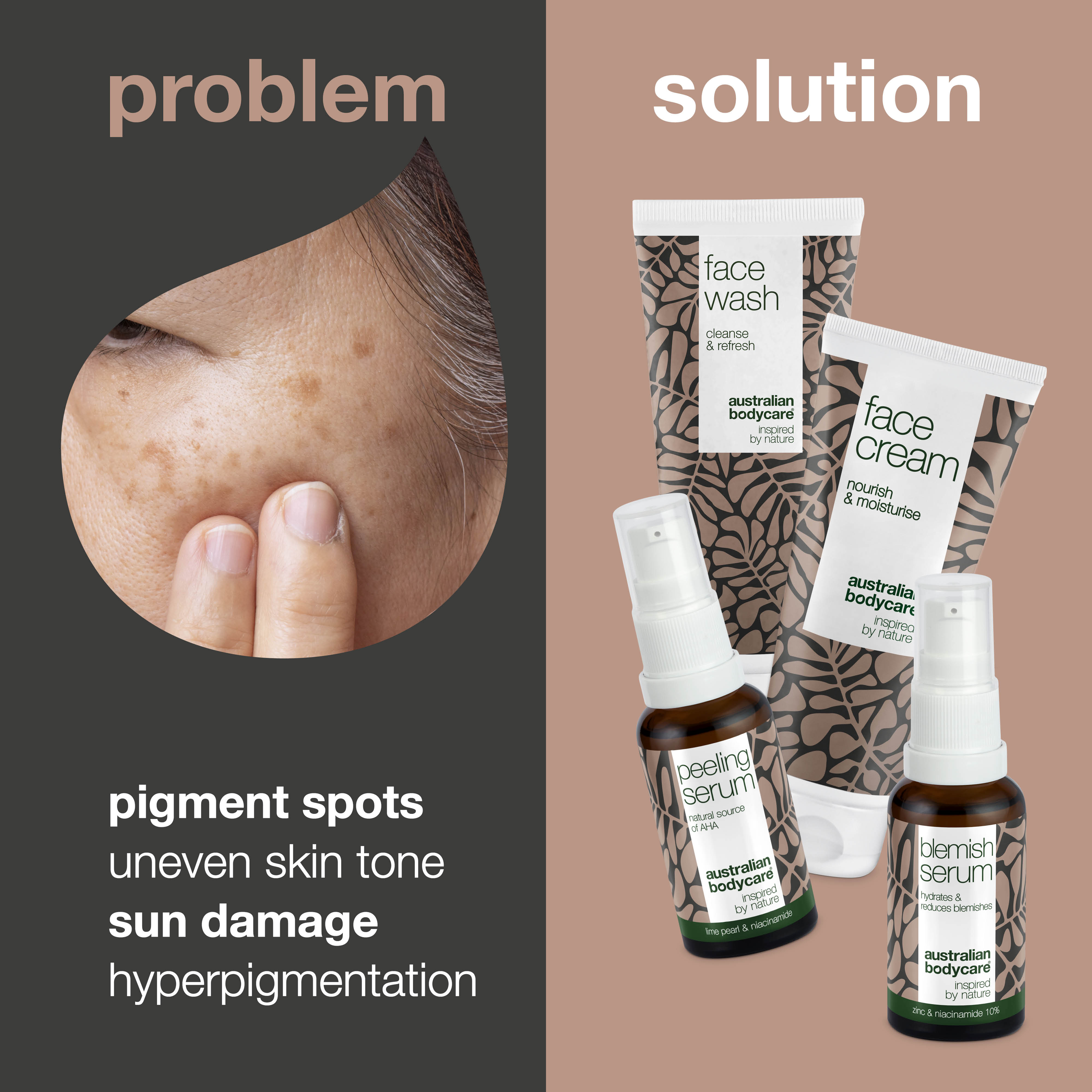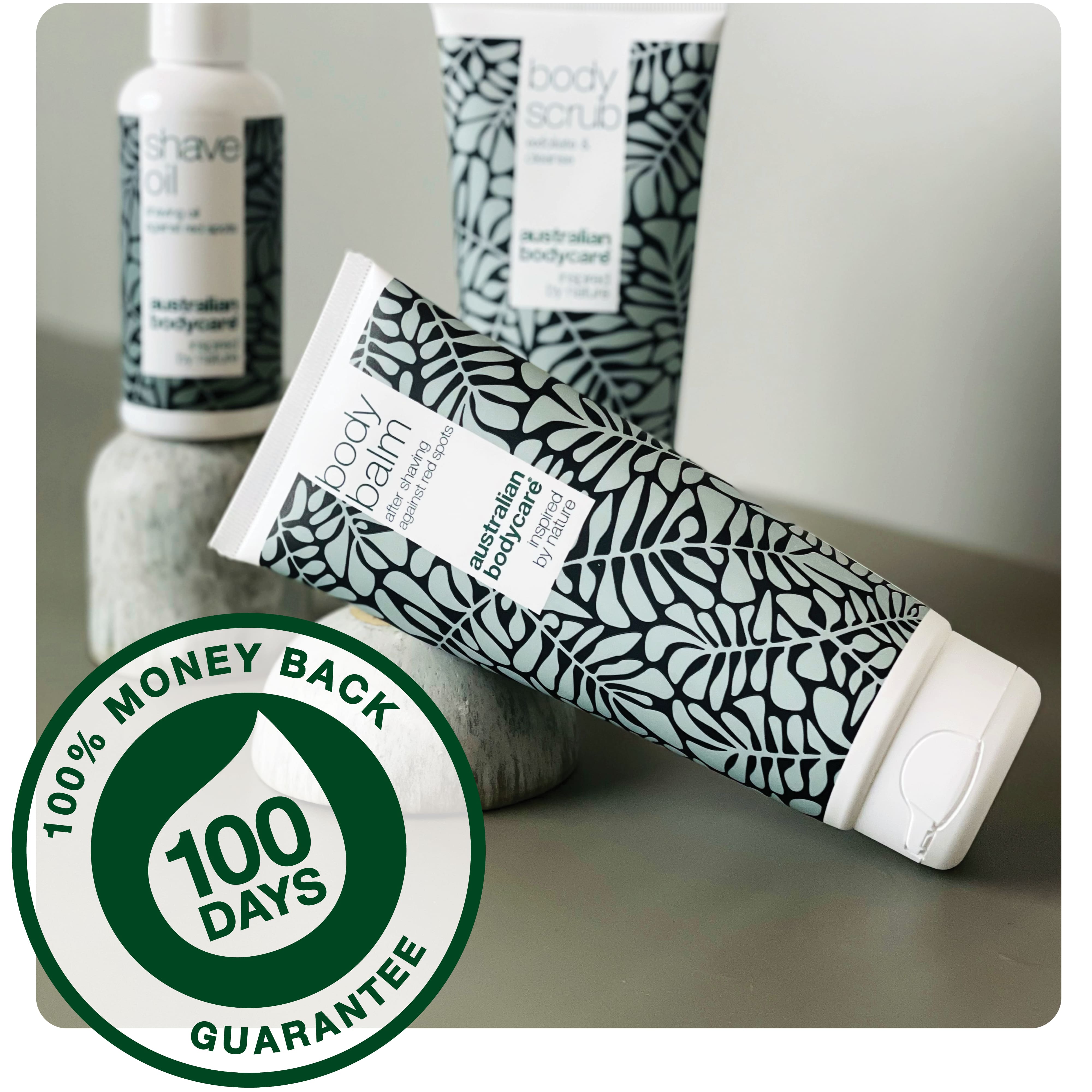Do you have pigment spots on your face or liver spots on your chest? Pigment changes cover both terms and are also known colloquially as pigment spots. Some people also call pigment changes pigment defects, but they are not defects - just changes in skin tone.
Whatever you call the unevenness in your skin tone, you know it can be a cosmetic nuisance - especially if it's on your face or chest. The products in this pack can help you if you want to minimise the visibility of your pigmentation spots.
How to use the products for daily face skin care:
1) If you use makeup, remove it first. Then cleanse your skin with the Face Wash. Massage into damp skin, not forgetting the neck and upper chest. Rinse thoroughly and pat dry.
You can use a face brush for daily cleansing. It exfoliates and removes dead skin cells, so your face products can penetrate the skin more easily and work actively.
2) Apply a few drops of Niacinamide Serum to clean face skin, neck and upper chest and massage in. Serum penetrates the skin quickly and works actively in the deeper layers of the skin.
3) Protect skin and moisturise with face cream. The face cream works as both a day cream and a night cream. The cream is gentle to use, so a small amount goes a long way.
You should use the products 2 times a day for best effect. Be aware that it is normal for the skin to clear out in the first few weeks, so you may risk breakouts such as pimples in the first few weeks after switching products. This will stabilise and improve after a month of consistent use of the products.
It can take 4 months to achieve improvement in the appearance of pigment changes and it is important that you use the products consistently and daily throughout this period.
1-3 nights a week, use the Peeling Serum like this:
After cleansing, pat skin dry. Now apply a few drops of Peeling Serum to your face - and possibly your neck and chest if you're also experiencing pigmentation changes here.
Peeling Serum should not be washed off, but left on the skin. Leave on for 30 minutes, then apply a few drops of Niacinamide Serum. Massage in and finish with a protective layer of Face Cream.
You should only use Peeling Serum a couple of times a week. For some, once a week is enough, while others benefit from using it 3 times a week. Experiment and find the frequency that works best for you and your skin.
OBS: It's normal for the skin to react with redness when you use the Peeling Serum the first few times. Peeling Serum exfoliates using AHA fruit acids and removes dead skin cells. It is quite harmless, but may cause redness of the skin until it gets used to the peeling. We therefore recommend that you exfoliate in the evening so that the skin can settle back down during the night.
We recommend that you always do a patch test of new products before using for the first time.
The products are suitable for all skin types, age groups and both men and women.
Why pigment spots appear in your skin
The vast majority of pigment changes occur due to too much sunlight. Therefore, it also makes sense that the proportion of pigment spots in your skin increases with age, when your skin has been more exposed to sunlight.
Freckles are also pigment spots, as they typically occur in the skin when it is exposed to UV sunlight. Therefore, if you have freckles, you will find that they become more visible (and perhaps many more) during the summer months.
The easiest way to prevent pigmentation changes in the skin is therefore to use sun protection - on the whole body. Also avoid the harsh midday and afternoon sun and keep your face especially protected, for example with a sun hat.
But it's not just sunlight that can cause pigment changes in your skin. Pigmentation spots - or liver spots, as they are also called - can also occur due to hormonal changes, for example during pregnancy, or when using special medicines or eczema creams.
How pigment changes form in the skin
The pigmentation changes in your skin can in the vast majority of cases be attributed to the sun. So while it's great to be out in, you need to protect yourself and be careful - even early in life. Too much sunlight and a lack of sun protection can contribute to the development of liver spots or pigment spots on your skin later in life.
Pigment changes often appear on the face and chest because they are bare in summer and exposed to UV radiation from the sun.
Pigmentation spots are caused by hyperpigmentation. Hyperpigmentation is caused by the overproduction of the substance melanin in the skin, which forms the dark pigment spots or light pigment changes in your skin. Pigment spots are not dangerous, but can be a cosmetic nuisance - for example on the face, chest and neck.
Why do the products in the package work?
The package is composed of products with carefully selected ingredients, which are beneficial if you want to minimize the visibility of your pigmentation spots on the face.
The Peeling Serum contains the Australian ingredient Lime Pearl, which is rich in AHA fruit acids. AHA has a positive effect on pigmentation spots as the chemical peel contributes smoothing properties to the skin. Skin tone is evened out, leaving your skin looking more even, smooth and fresh.
Niacinamide, contained in Blemish Serum, reduces the transfer of pigment into the skin, allowing you to minimise the appearance of pigmentation changes.
Face Wash and Face Cream keep skin in top condition, minimising and preventing skin problems.
What do I do if I am not satisfied?
It is important that the products are given enough time to work. It can take up to 20 weeks before you start to see a positive change with your pigmentation spots. You should therefore expect to use the products in the pack for 4-5 months before you see results.
If - against your expectations - you don't get the results you want, you can make use of the satisfaction guarantee. This only requires that the products have been purchased here in the webshop. Read more about the conditions and procedure here.
You might also be interested in our guides on liver spots and pigment changes?
Hyperpigmentation - this is how you even out your skin tone
Pigmentation: How to prevent and treat it
Dark spots on the skin – How to reduce them
Freckles – reduce freckles for an even skin tone
Age spots: how to deal with them










